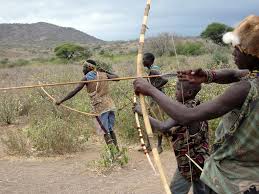EXPLORE: Human Population
| Site: | Mountain Heights Academy OER |
| Course: | Earth Science Q4 |
| Book: | EXPLORE: Human Population |
| Printed by: | Guest user |
| Date: | Saturday, 26 July 2025, 9:55 AM |
Description
GA Virtual Learning Shared Content Terms of Use
By viewing or downloading content from this page, the school/user agrees to the terms and conditions of the End User Licensing Agreement. To view the agreement, click here
Periods of Human Population Growth
Throughout human history, there are four major periods of human population growth.
1. The Hunter/Gatherer Period. During this time, the total human population was less than a few million. People were mostly hunters and gathers who lived in small groups that moved around as needed to find food.

Hunter gatherer populations experienced lower population growth rates. Photo courtesy of Flickr.
2. Agricultural Revolution: The agricultural revolution enabled people to settle in villages and raise crops and domesticated animals. This period is when the first major increase in human population occurred.
Agriculture is very important to an increase in human population growth rates. Image courtesy of Wikimedia.
3. Industrial Revolution: During this time improvements in health care and food supply led to rapid increases in the human population.
During this time improvements in health care and food supply led to rapid increases in the human population.
The Industrial Revolution led to a rapid growth in human populations. Photo courtesy of Wikimedia.
4. Information/Globalization Revolution: This period involves the use of new technologies to obtain access to a large quantity of information on a global scale. Some examples of these technologies include computers, the telephone, radio, and television.

Globalization led to easier access to information. Photo courtesy of Wikimedia.
Population Growth
A population is a group of individuals of the same species that lives in a particular area. The population growth rate is the difference between the birth rate and the death rate in that population. Populations can grow rapidly if there is no resistance from the environment and resources are plenty. The carrying capacity of a population is determined by environmental resistance; if resources become scarce, a population's growth rate will decrease. If a population is not limited by the availability of resources, it can grow exponentially; in the past, human population growth has exceeded the rate of exponential growth.Can the planet sustain the growing human population or are we exceeding Earth's carrying capacity? Carrying capacity is the supportable population of a given species and is dependent upon the resources available in that location. The world's human population reached one billion people in 1802. By 1961, it had tripled to ~ 3 billion, and reached 7 billion by 2011.
Watch the following video:
Source: Growth of Human Populations. Retrieved from http://www.ck12.org/book/CK-12-Earth-Science-Concepts-For-High-School/r16/section/13.1/ on December 27, 2013.
Population Growth & Environment

Overpopulation has huge impacts on the environment. Photo courtesy of Wikimedia.
Many people think that Earth is so large that human activities couldn't possibly make much of an impact on the planet. But, human populations have expanded at a more than exponential rate. We are using more resources and producing more waste than ever before. This has impacts on the environment.
Different environmental factors limit where populations can exist. Space, clean air, clean water, good soil and enough food to support a population are limiting factors in some locations. But, human ingenuity from advances in farming that has kept so many people alive. Technology has altered the impact that each individual human has on the environment, primarily because technology increases the use of resources.
There are limiting factors for human population growth. Some are short-term factors, creating apparent effects to the population within the same year the event occurs. Examples of such events include drought, natural hazards (e.g. earthquakes, tsunamis, hurricanes) and disease. Immediate-term factors are those that produce noticeable effects within 1-10 years. Examples include energy shortages that affect agriculture, desertification, and a decrease in the supplies of nonrenewable resources. Long-term factors are events that would not cause apparent effects until 10 years after the event occurred. Examples include soil erosion, loss of groundwater, and climate change (global warming).